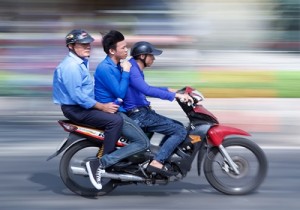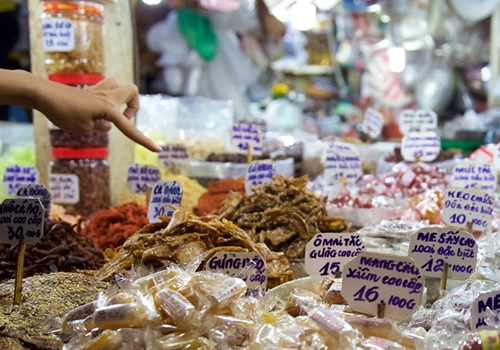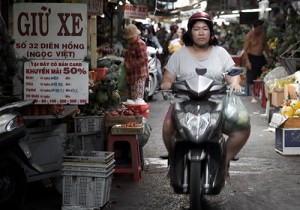One of University of Toronto student Ongio Tsui’s favourite mementos from his recent journey to Vietnam is a cell phone video of him riding on the back of one of Ho Chi Minh City’s ubiquitous motorbikes.
There are over seven million motorbikes in the city of over eight million people, and bike culture permeates every aspect of Vietnam’s largest metropolis, as Tsui — who is in his fourth year in the Dr. David Chu Program in Contemporary Asian Studies at the Munk School’s Asian Institute — discovered during a field trip with anthropologist Hy Van Luong and a group of other students. The February field trip was part of the Faculty of Arts & Science International Course Module Program (ICM).
“The only people without motorbikes are three-year-old kids”

“The only people without motorbikes are three-year-old kids,” jokes Luong, who took the students to compare urban development in more laissez-faire Ho Chi Minh City with orderly and authoritarian Da Nang, a coastal tourist city of a million people.
“It’s very hard to find a slum in Da Nang, but not in Ho Chi Minh City,” says contemporary Asian Studies student Susan Cui.
Da Nang & Ho Chi Minh City: A study in opposites
Forty years after the end of the Vietnam War, and over a quarter of century since the country opened up to foreign investment, the two cities are a study in opposites.
One of Da Nang’s official mottos is “No Beggars.” The city has defied the country’s central government and the nation’s constitutional guarantees of freedom of movement and residence by turning back all beggars from other provinces, and by not allowing poor and less educated migrants to live in the core of the city.
Migrant industrial workers are told to settle in the outskirts of the model city, which has recently torn down many vestiges of French colonial rule such as its old opera house in favour of a gleaming new downtown core of hotels and high-end commercial development.

Da Nang’s clean streets and low crime rate stand in stark contrast to the hurly burly of Ho Chi Minh City, and it gets glowing reviews from the country’s media. “They have achieved more or less what they said they wanted,” says Luong.
Cui and Tsui give kudos to Luong for the way he structured the week-long trip, allowing them to pair up with local student guides to explore and do their own research after completing the official tours and meetings with city officials and academics.
“The tours were great for getting a sense of how each city was structured, and we got some interesting information from the officials and academics,” says Cui, whose research focused on infrastructure and development.
“But I felt like I was able to experience both cities and get done what I wanted to without any real barriers, because of those students.”

Student guides invaluable connection to youth culture
For Tsui, the student guides were an invaluable resource for exploring his interests in youth culture.
“Having those guides, who were the same age as us, provided first-hand insights that weren’t available to me back in Canada or in text books, says Tsui.
“It was information that also might not have been available to older academic researchers because of the age gap.”
In Ho Chi Minh City, some of the most revealing exploration was done on motorbikes, which fuel the city’s free-for-all economy of sidewalk vendors and pop culture, defying attempts to channel commuters to slower but more orderly public transit buses.
Residents have a sentimental attachment to their bikes, and riders sport the latest fashion trends in helmets and face masks to protect them against grit and pollution in the traffic-congested city.
Balancing the old and new — sometimes with chaotic results
Cui says Ho Chi Minh City reflects the kind of development that is reminiscent of Shanghai in her native China, both cities trying to balance the old with the new, sometimes with chaotic results.
A number of buildings of the Ho Chi Minh City’s famous French colonial architecture are protected by historical preservation laws. Rich new villas and ramshackle housing stand side by side in the city formerly known as Saigon, which Luong says is trying to move away from labour-intensive industries in favour of a knowledge-based economy.
“The larger context is not just Vietnam alone,” says Luong. “Urban planners and governments throughout Asia and in Africa and Latin America are trying to manage cities that are growing very fast.”

